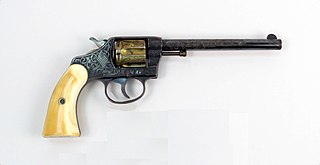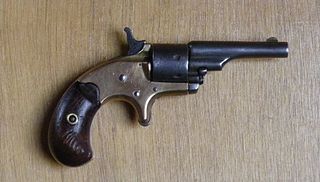
A revolver is a repeating handgun that has at least one barrel and uses a revolving cylinder containing multiple chambers for firing. Because most revolver models hold up to six cartridges, before needing to be reloaded, revolvers are commonly called six shooters.

A derringer is a small handgun that is neither a revolver, semi-automatic pistol, nor machine pistol. It is not to be confused with mini-revolvers or pocket pistols, although some later derringers were manufactured with the pepperbox configuration. The modern derringer is often multi-barreled, and is generally the smallest usable handgun of any given caliber and barrel length due to the lack of a moving action, which takes up more space behind the barrel. It is frequently used by women because it is easily concealable in a purse or a stocking.

The .32 S&W Long, also known as 7.65x23mm, is a straight-walled, centerfire, rimmed handgun cartridge, based on the earlier .32 S&W cartridge. It was introduced in 1896 for Smith & Wesson's first-model Hand Ejector revolver. Colt called it the .32 Colt New Police in revolvers it made chambered for the cartridge.

The Lemat revolver was a .42 or .36 caliber cap & ball black powder revolver invented by Jean Alexandre LeMat of France, which featured an unusual secondary 20 gauge smooth-bore barrel capable of firing buckshot. It saw service with the armed forces of the Confederate States of America during the American Civil War of 1861–1865 and the Army of the Government of National Defense during the Franco-Prussian War.
Robert Adams (1810–1870) was a 19th-century British gunsmith who patented the first successful double-action revolver in 1851. His revolvers were used during the Crimean War, the Indian Mutiny, the American Civil War, and the Anglo-Zulu War.

The Remington Zig-Zag Derringer, or "Pepper Box", originally termed "Elliot's Pocket Revolver", was made 1861–1862 with fewer than 1,000 manufactured.

An antique firearm is a term used to describe a firearm that was designed and manufactured prior to the beginning of the 20th century. Although the exact definition of what constitutes an "antique firearm" varies between countries, the advent of smokeless powder or the start of the Boer War are often used as cut-off dates. Antique firearms are usually collected because of their historical interest and/or their monetary value.

A handgun is a firearm designed to be usable with only one hand. It is distinguished from a long gun which needs to be held by both hands and braced against the shoulder. Hand guns have a shorter range compared to the long guns. The two most common types of handguns are revolvers and semi-automatic pistols, although other types such as derringers and machine pistols also see infrequent usage.

In firearms, the cylinder is the cylindrical, rotating part of a revolver containing multiple chambers, each of which is capable of holding a single cartridge. The cylinder rotates (revolves) around a central axis in the revolver's action to sequentially align each individual chamber with the barrel bore for repeated firing. Each time the gun is cocked, the cylinder indexes by one chamber. Serving the same function as a rotary magazine, the cylinder stores ammunitions within the revolver and allows it to fire multiple times before needing to reload.

The Colt Walker, sometimes known as the Walker Colt, is a single-action revolver with a revolving cylinder holding six charges of black powder behind six bullets. It was designed in 1846 by American firearms inventor Samuel Colt to the specifications of Captain Samuel Hamilton Walker.
Nighthawk Custom is an American firearm company based in Berryville, Arkansas, US, that manufactures custom M1911 pistols, rifles, revolvers, shotguns, and tactical knives for competition shooters, military, law enforcement and self-defense.
Davide Pedersoli & C. is an Italian firearms manufacturing company based in Gardone Val Trompia, Italy, that was founded in 1957 by Davide Pedersoli.

The Colt New Police is a double-action, six-shot revolver. This gun was chambered in the .32 New Police, which is dimensionally identical to a flat-nose version of the .32 S&W Long, except for the nose shape. In addition to the .32 New Police cartridge, the revolver was available in 32 Colt. The diameters of the two cartridges are not the same, with the 32 Colt being approximately 0.020 inches smaller in diameter than the New Police. Although the 32 Colt can be loaded and fired in the New Police chamber, it is not recommended to do so. It is impossible to load the .32 New Police in a 32 Colt chamber. The later .32 New Police chambering was more popular than the 32 Colt chambering.
A gallery gun, Flobert gun, parlor gun or saloon gun is a type of firearm designed for recreational indoor target shooting. These guns were developed in 1845, when French inventor Louis-Nicolas Flobert created the first rimfire metallic cartridge by modifying a percussion cap to hold a small lead bullet. In the 19th century, gallery guns were typically pump-action rifles chambered in .22 Short. Gallery guns are still manufactured, although by the late 20th century, they have been eclipsed by airguns for the purpose of indoor shooting.

The Colt New Line was a single action pocket revolver introduced by the Colt's Patent Fire Arms Manufacturing Company in 1873.

The Colt Model 1855 Sidehammer, also known as the Colt Root Revolver after engineer Elisha K. Root (1808–1865), was a cap & ball single-action pocketrevolver used during the American Civil War and made by the Colt's Patent Fire Arms Manufacturing Company

The Colt House Revolver was one of the first metallic cartridge rear-loading revolvers to be produced by the Colt's Patent Fire Arms Manufacturing Company, in 1871. The same year, Colt's also patented the Colt Open Top, another metallic cartridge rear-loader, but in fact the Open Top production didn't start until 1872, although a pocket version of the Open Top, a completely different design, went on sales as of 1871, the Colt Open Top Pocket Model Revolver.

The Colt Model 1871–72 Open Top is a metallic cartridge rear-loading .44-caliber revolver introduced in 1872 by the Colt's Patent Fire Arms Manufacturing Company. This handgun was developed following two patents, the first one in 1871 and the second one in 1872, it is estimated that the production span lies primarily between February 1872 and June 1873. There is therefore still some confusion when naming it. It is sometimes named Colt Model 1871 or Colt Model 1872 but at this time the most common accepted names are Colt Model 1871–72 Open Top, Colt Model 1871–72 or simply Colt Open Top.

The Colt Open Top Pocket Model Revolver was a single action pocket revolver introduced by the Colt's Patent Fire Arms Manufacturing Company in 1871. Introduced a year before the Colt Open Top and two years before the Colt Peacemaker and the Colt New Line, the Colt Open Top Pocket Model Revolver was, alongside the Colt House Revolver, one of the two first metallic cartridge rear-loading revolvers manufactured by Colt's. It also was one of the first pocket metallic cartridge revolvers made by the company.
Forehand & Wadsworth was an American firearms manufacturing company based in Worcester, Massachusetts. It was formed in 1871 by Sullivan Forehand and Henry C. Wadsworth after the death of their father-in-law, Ethan Allen of Ethan Allen & Company, and was acquired in 1902 by Hopkins & Allen, a firearms company based in Connecticut.
















